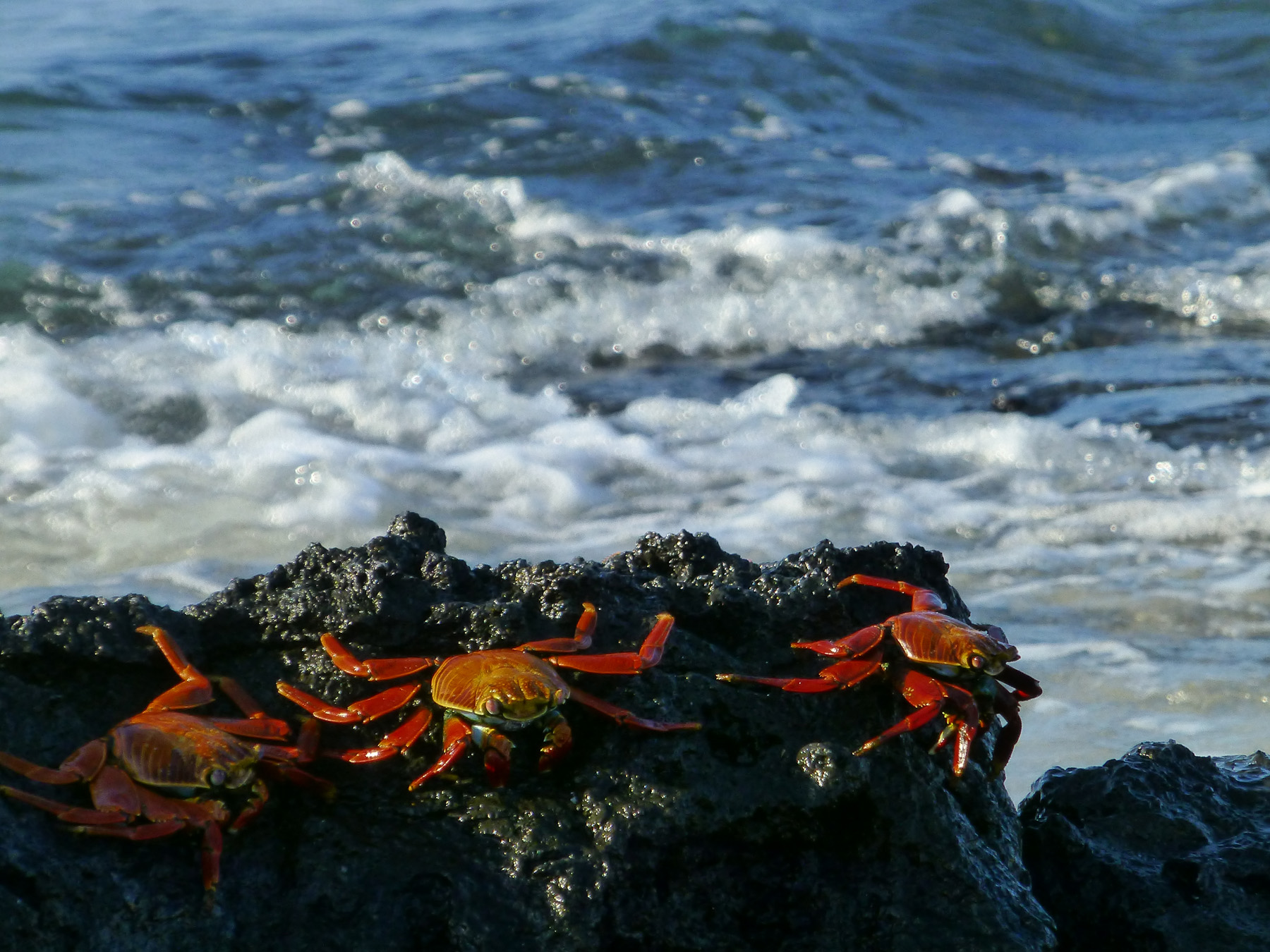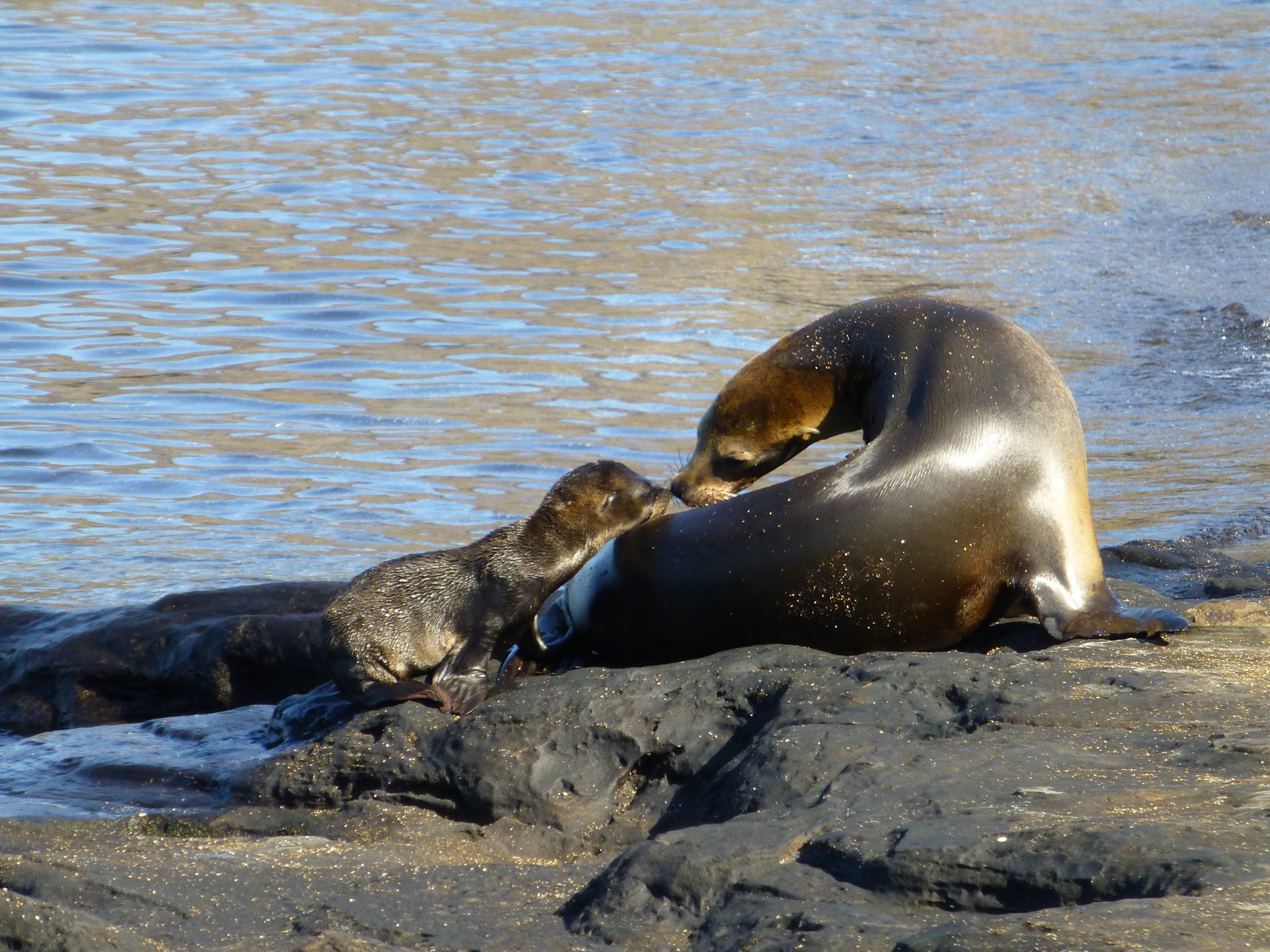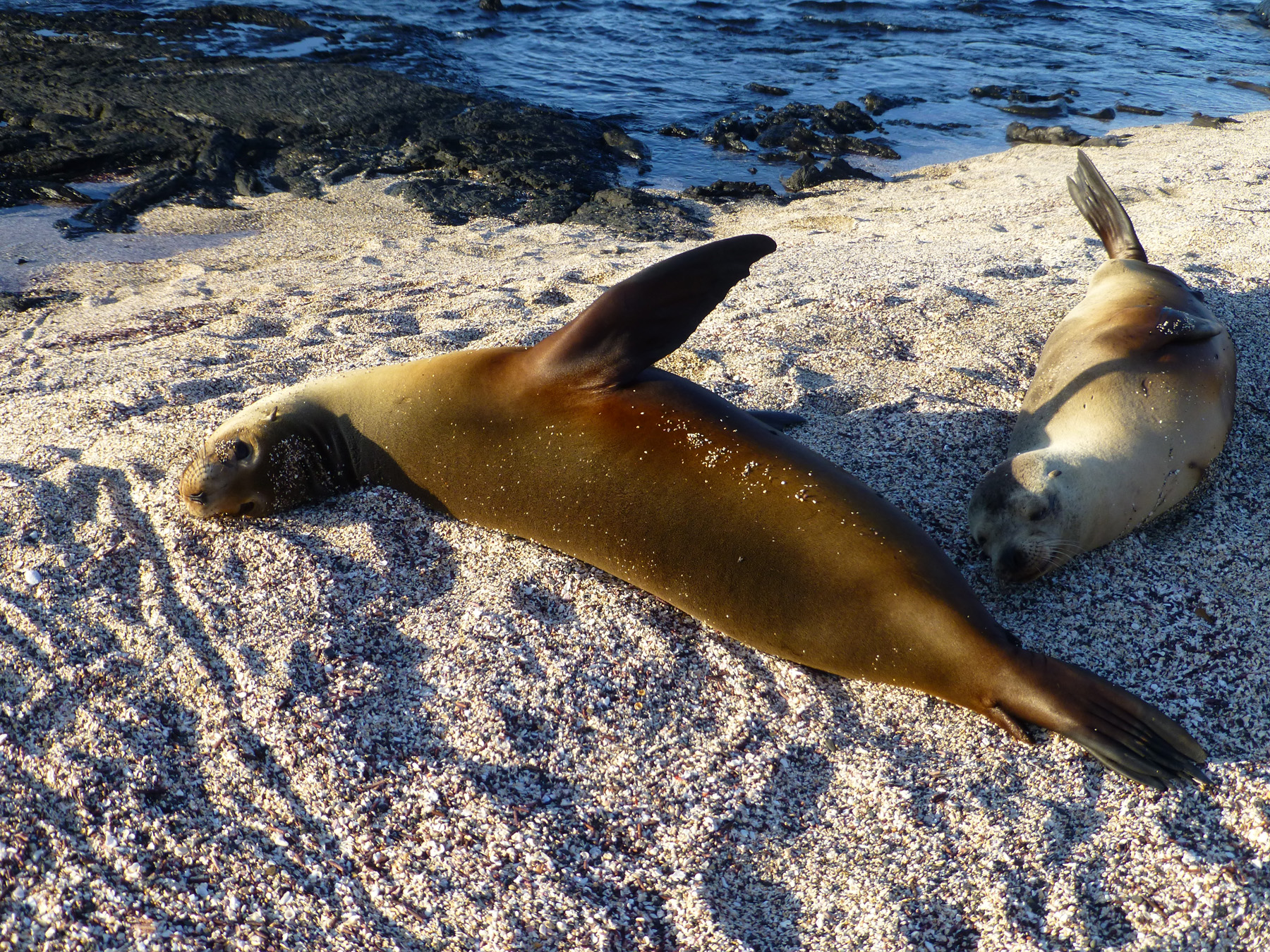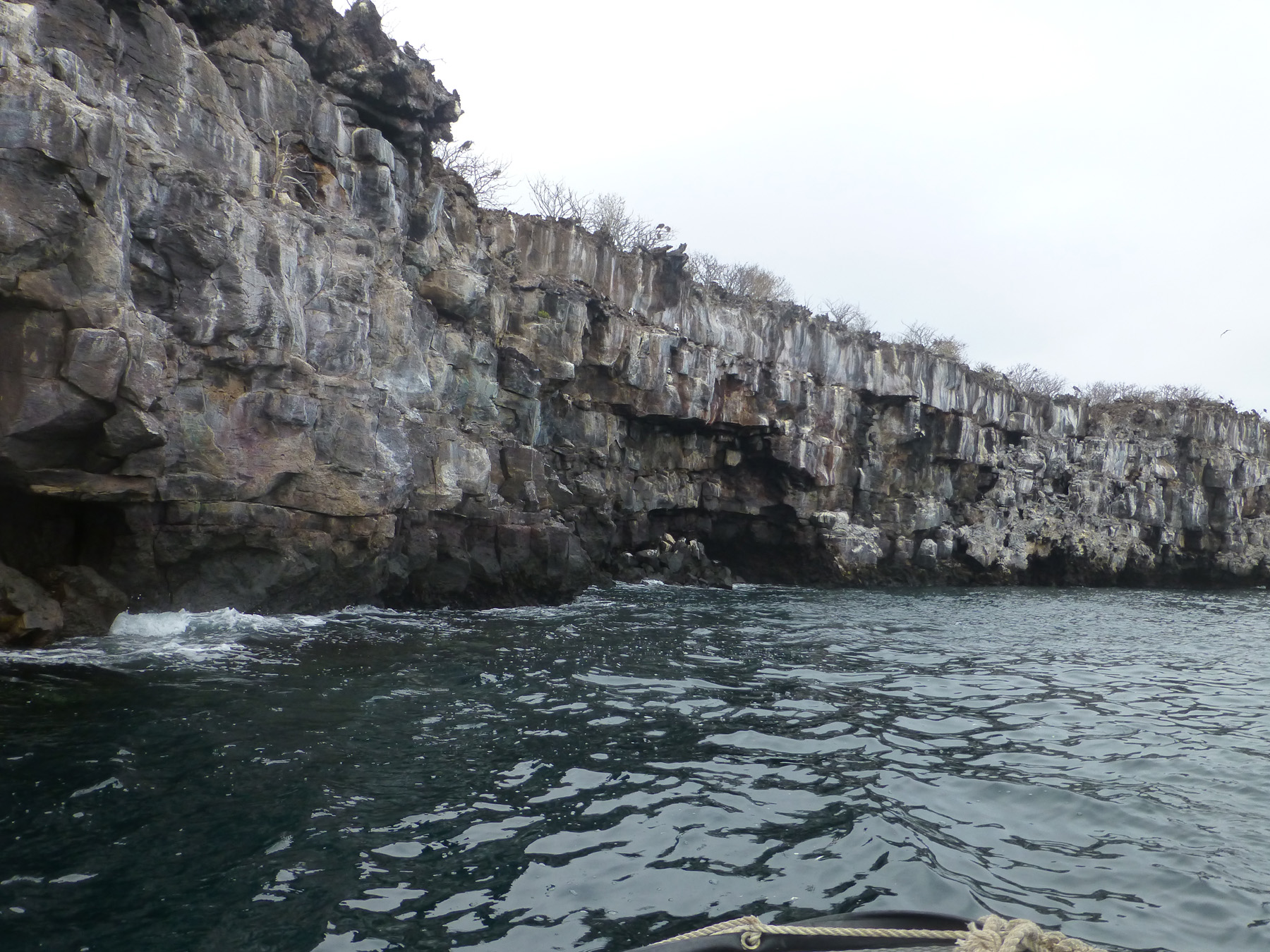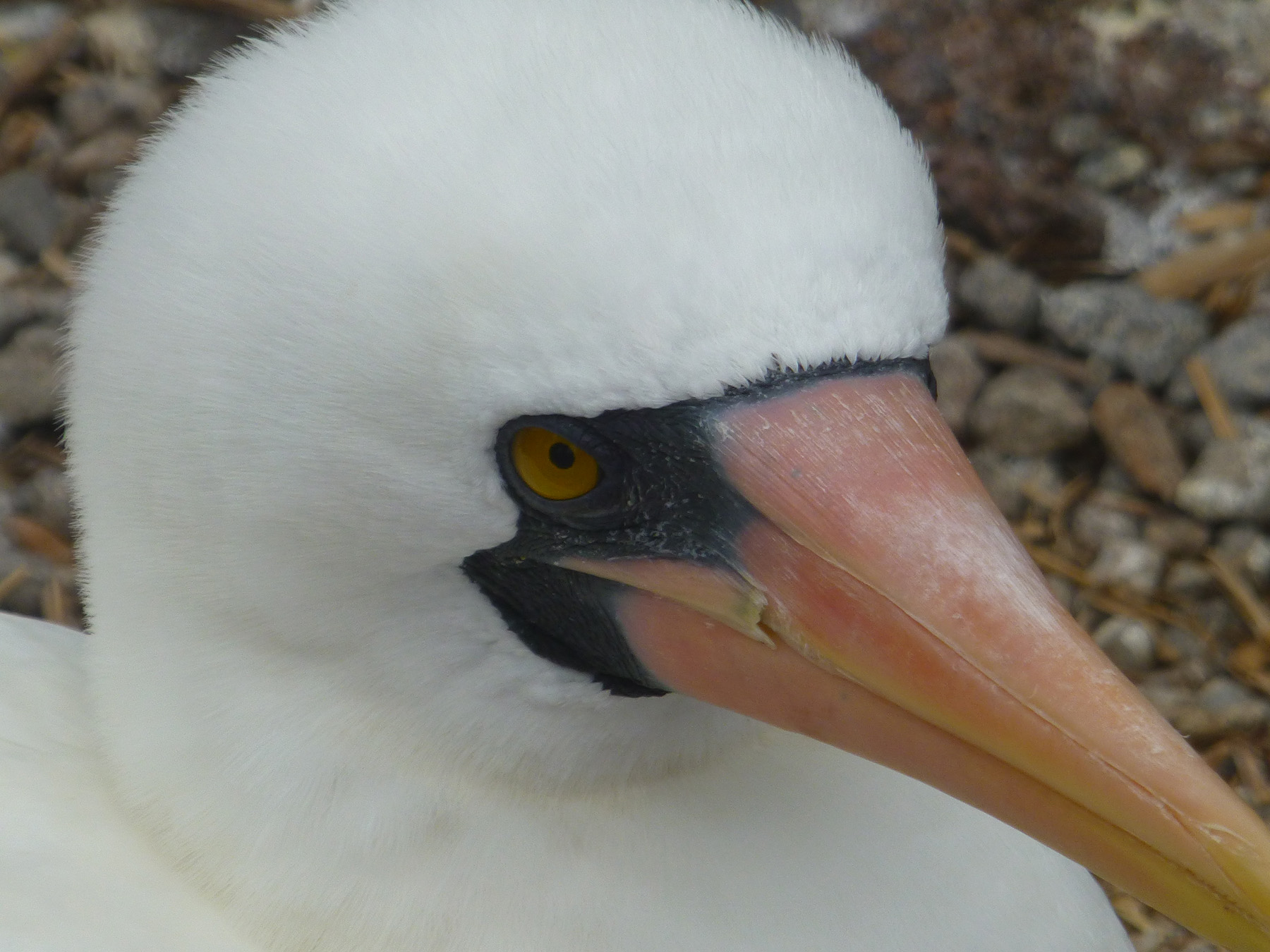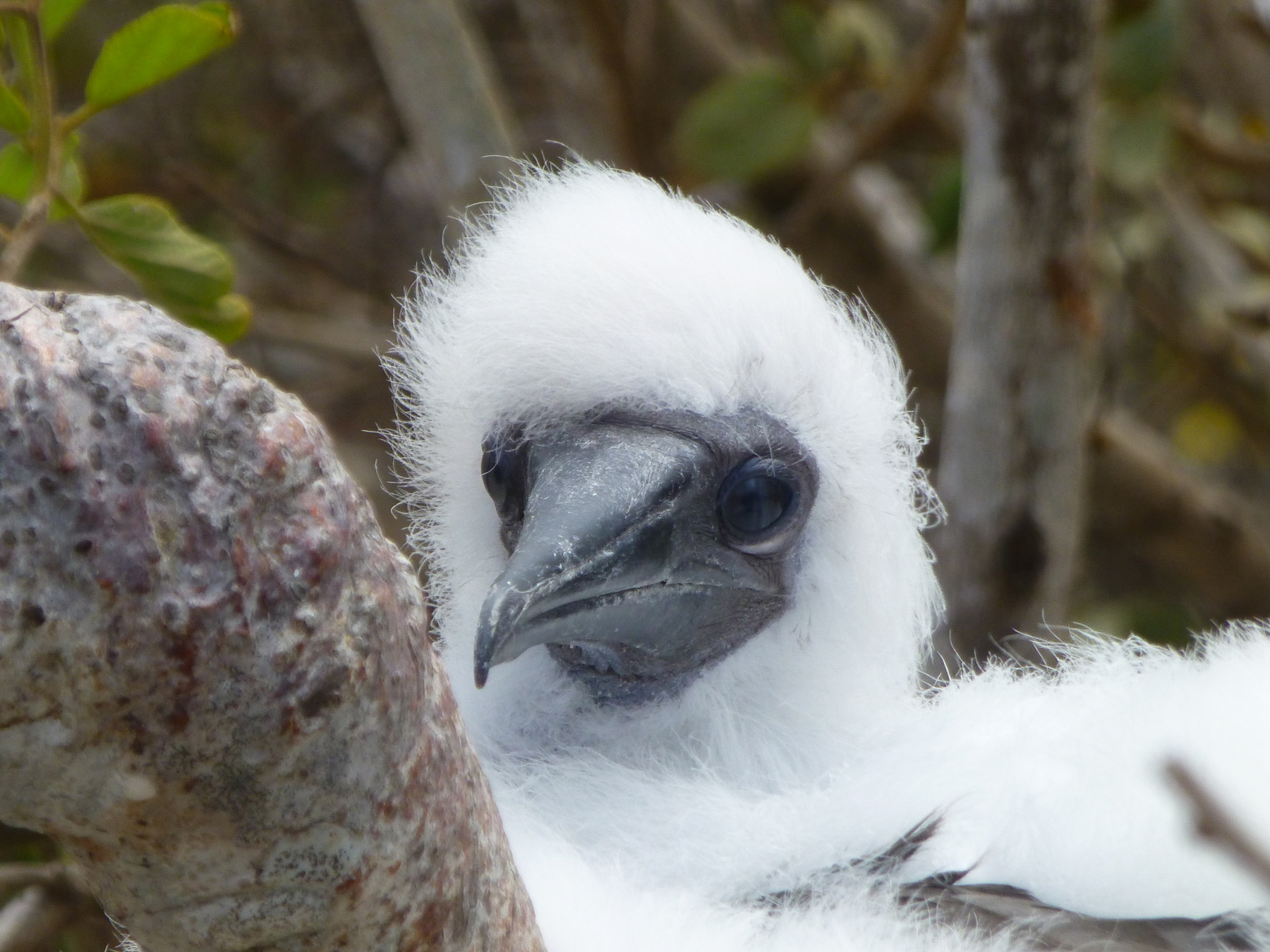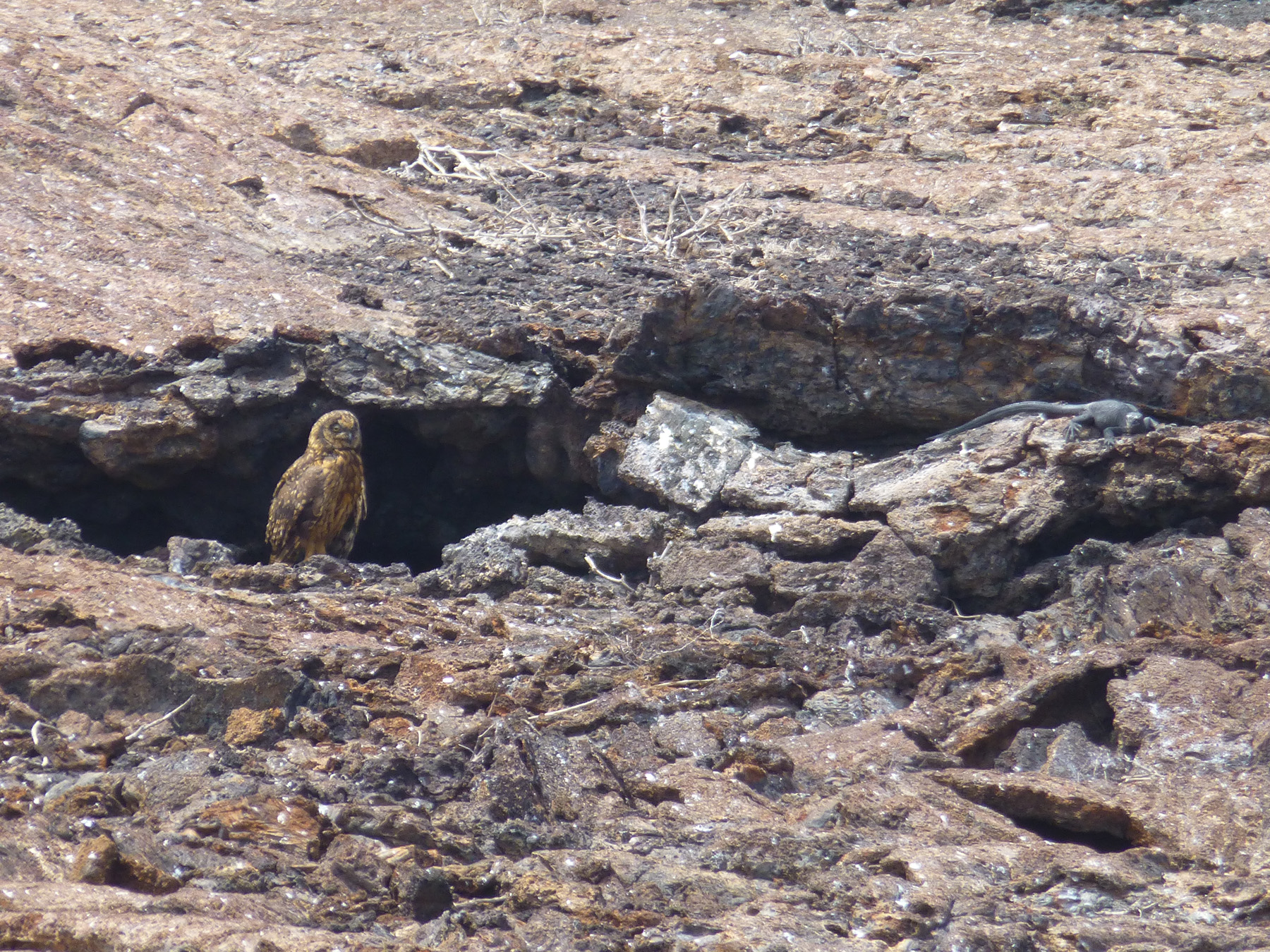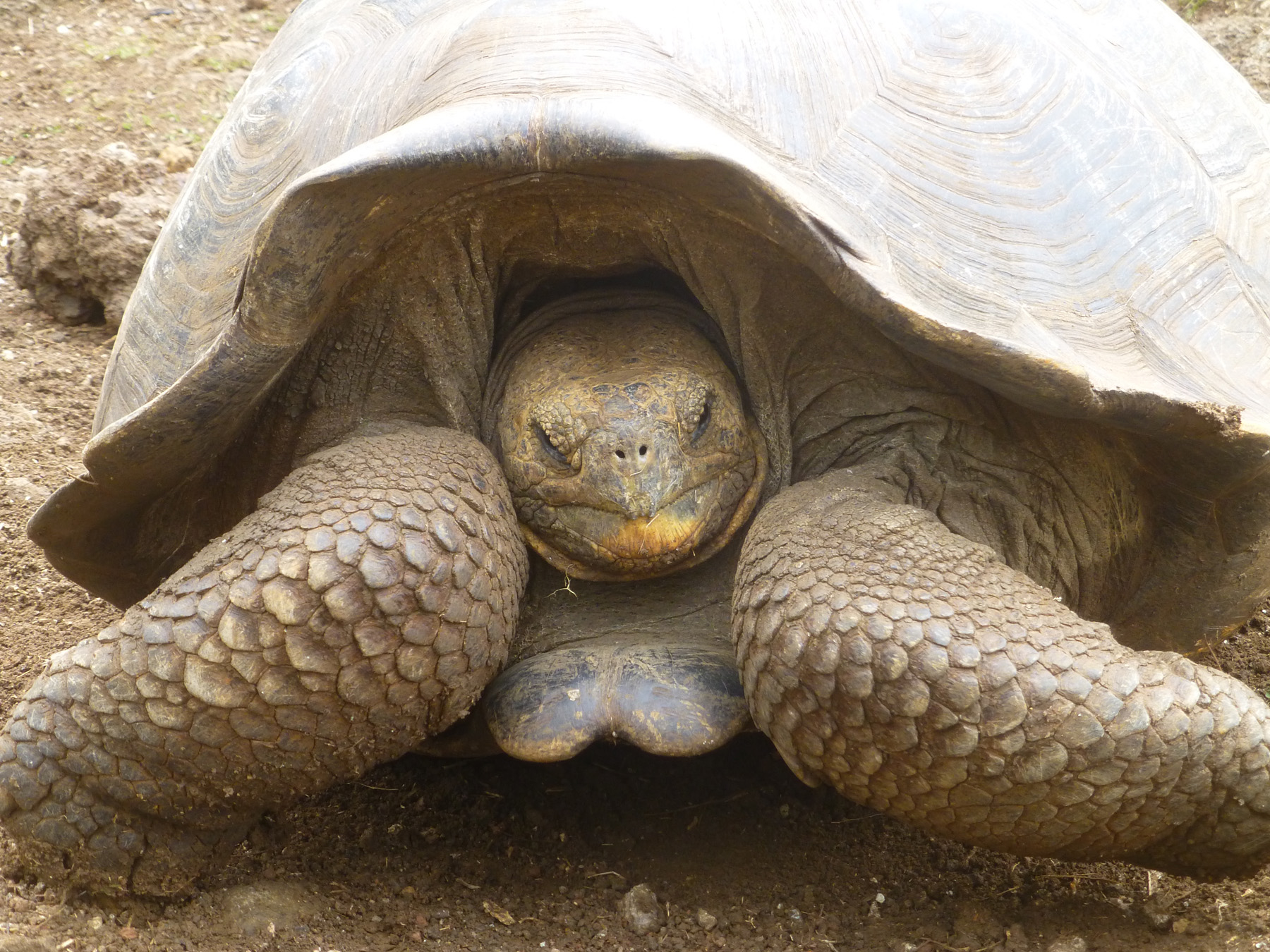Sept 23 - 27, 2013 - Galapagos Islands, Ecuador
When you’re suffering from a cold and you wake up at 2:30 in the morning to catch a 3:00AM van ride that takes you across rough jagged stones for over an hour, then spend another hour on paved roads, only to spend two hours waiting at an airport before spending several hours flying, landing, and flying again, then add another hour moving like cattle with 80 other people onto a bus so that you can ride a dinghy across rough seas and end up on a small cruise ship that’s slowly rocking back and forth, back and forth, back and forth on an incessant ocean… Well, you don’t feel great. That was how our Galapagos journey began.
A week earlier we were sitting in Sacha Lodge discussing the mind-blowing awesomeness of the Galapagos with our new friends, Guillaume and Mathilde. They’d just spent 8 days cruising around the islands and were extolling its many wonders: fish, birds, turtles, sea lions – all up close and personal. Many months ago Katie and I had written off touring the Galapagos because of the price. It’s very expensive. We shopped around and found that it if you do it on the cheap the cost downgrades from very expensive to expensive. Either way, we weren’t ready to shell out many thousands of dollars for a few days in the Galapagos. We’d come back someday when we were richer. (Yeah, right.)
But sitting there, listening to the unprecedented magic of the Galapagos Isles, it was difficult not to reconsider. And the moment Guillaume and Mathilde mentioned that other people on their boat had spent a fraction of the cost on last minute deals we were sold. At least partially. We wanted to hear those deals first.
When we returned to Quito we followed their advice and visited a travel agent named Robin at Sangay Tours. Robin was a Canadian gentleman, though you never would’ve guessed it. He had a muddled English accent, spoke fluent Spanish, and looked like Peter O’Toole in the last reel of Lawrence of Arabia…minus the Arabian garb, of course. Guillaume had described him as a fair man who’d be upfront and honest with us about the rates, tours, and what our best options were. Guillaume was right. Robin was a fount of knowledge. He knew the boats, the islands, the companies, and the pros and cons of all. We spent an hour talking with him about the bottom line, and in the end we signed it. What did we get in return? Airfare and passage for two aboard the Santa Cruz for 5 days and 4 nights.
(Psssst…they chose the cheapest option.)
Yes, strange disembodied voice, it was the cheapest option, but it was also the one we liked best. It held many pros: the itinerary was the most appealing, there were English-speaking guides, the food was supposed to be great, and the boat was big, which meant less chance for seasickness. Seasickness, you see, was a major worry for us. Both Katie and I suffer from it, but Katie more so. To drive my point home, before we left the U.S. we bought Dramamine, Bonine, anti-nausea homeopathic oil, and those bands you wear around your wrists to engage pressure points. (Ours look like the ones patients wear in hospitals. Very stylish.) To top things off, Mathilde gave us extra anti-seasickness patches that she used on her cruise. So, with our anti-nausea arsenal at the ready, Katie finally acquiesced and surrendered herself to life on a boat for five full days.
As I mentioned before, things started out a bit rough. That first evening on the Santa Cruz we felt like we’d spent an entire day at the amusement park. Drained and numb, we weren’t too eager to eat let alone socialize. We’d suddenly found ourselves surrounded by American retirees, median age 65. Everyone around us was talking and laughing and toasting the start of their journey. We just stared at each other and rocked. At dinner we spoke to no one and turned in before anyone had finished dessert. A light meal and early trip to bed? Maybe I had more in common with the other guests than I thought.
By morning we felt human again. I won’t say we were right as rain, because we weren’t. Things just don’t feel right on a boat. Your body knows circumstances are abnormal and yearns for a status quo. Are we going to rock and roll or stand on solid ground? Make up your mind, already! Trouble was, we couldn’t. Every day was a mix of the two. I loved our daily excursions out to the islands where I could walk on land and not worry about a shift in tide. But those trips were short-lived. Suddenly we’d be back on the boat for more eating, eating, eating. Three monstrous meals a day were provided plus snacks whenever we returned from shore. Suffice to say, if we weren’t looking at wildlife we were being plied with food. So, despite all that snorkeling, I think I actually gained weight on this trip.
The good news is that after 3 days aboard the Santa Cruz Katie and I found our sea legs. No more queasiness. No more minding that rolling underfoot as we bumped into strangers at lunchtime. We could stuff our faces in relative comfort knowing that nothing was going to make a surprise reappearance. A good thing, too, because we needed to get our money’s worth out of those bottomless buffets!
In spite of the rough beginning to our journey, the Galapagos Islands fulfilled its promise of magic and wonder. During our 5 days aboard the Santa Cruz we traveled to 4 different islands: Santa Cruz (where do you think our ship got it’s name?), Santiago, Genovesa, and San Cristóbal. You’d think this archipelago would be roughly the same as you traveled from one place to another, but you’d be wrong. Each island had its own topography and sometimes its own unique wildlife.
During our first excursion we walked along Las Bachas Beach on Isla Santa Cruz and witnessed blue-footed boobies gracefully swooping overhead. Then, without warning, they’d retract their wings and plunge into the sea like torpedoes. This was their fishing technique. They often came up empty handed, but they were tireless in their efforts. The beach, itself, was covered in organic white sand made up of broken down coral, shells, and other animal byproducts. Being organic, the sand never gets hot. You could walk on it barefoot under the blazing sun and never have to worry about blistering. It was on this beach that we spotted our first Sally Lightfoot crabs and black marine iguanas. The crabs were fiery orange and yellow and appeared to be dancing across the rocks (hence, their name). The iguanas turned out to be adept swimmers. Their long black tails swung back and forth, propelling them through water like alligators. Luckily for us, their appearance was far less intimidating.
That night we cruised over to Isla Santiago. In the morning we were taken to Buccaneer’s Cove for some deep water snorkeling. Everyone was decked out in gear and wetsuits as we sat on a Zodiac awaiting the plunge. Now, when I say “deep water” snorkeling I don’t mean open water or deep sea. All it means is deeper water than if you went snorkeling off a beach. You can’t touch the ocean floor but you can see it. Katie, who’s never hidden her fear of the ocean and sharks, swallowed her anxiety and jumped into the water with me. Right away we saw a Galapagos sea lion dip in and swim around us curiously before darting away. Then we saw a white-tipped reef shark hunting along the seafloor. I checked to make sure Katie was OK. She gave me the thumbs up. We continued on, admiring the tropical fish and a school of sardines twinkling in the sunlight. After several minutes, however, Katie began to panic. Her breathing became erratic and she felt uneasy. I held her hand as we swam, but she kept popping her head up, uncomfortable with being underwater, so we returned to the boat. We both decided that deep water snorkeling wasn’t for her.
Luckily, that afternoon we were able to experience snorkeling from the beach at Puerto Egas. This successfully wiped away Katie’s bad memories. Katie was calm and cool during our entire time in the ocean. Even better, the quality of the snorkeling surpassed what we’d experienced earlier in the day. We saw sea lions aplenty, tropical fish, three sea turtles, and even an octopus! We came across the sea turtle quite unexpectedly, so much so that Katie could barely stop herself from ramming into it. A few moments later a couple more turtles appeared around the bend. Then we came across an octopus billowing out of the rocks. It sensed our presence and propelled away before blending into the seafloor again. It was an extraordinary swim that made you want to float along with all the activity of the sea.
(Below is a video showcasing the highlights of our underwater adventures. Katie didn't use music, so you will really be able to see and hear what it was like snorkeling around the Galapagos Islands.)
Sea lions and their cubs were scattered over the beach, so when we weren’t in the water we were wandering around enjoying their barks and toddling. This beach was black sand, composed of broken down lava rock. I could immediately feel the heat radiating from it. We kept our sandals on during our stroll. Our group continued inland for a tour along hardened lava flows to see more wildlife. Hundreds of marine iguanas lazed about on the rough seashore, sometimes lying in piles on top of one another (they sleep this way to keep warm). Now and then an iguana would sneeze, but don’t worry, they weren’t sick. This is their way of extracting salt from their bodies. Because fresh water is so scarce in the Galapagos, these iguanas have evolved to drink seawater. They simply snort out all the salt. Very impressive!
The next morning we visited a red sand beach on the small islet of Rabida Island off the coast of Santiago (yep, we were hitting every color in the beach spectrum). We took a short hike around a lagoon and up into the hills. Prickly pears sprouted out of the ground and Darwin finches of all kinds greeted us along the trail. Afterward we had the option of deep water snorkeling or beach snorkeling. We opted for the later for obvious reasons. I was thrilled because nearly everyone left, so the water wasn’t crowded when I went out for another snorkeling venture. Katie decided to stay on dry land to enjoy solid ground for a while. It was probably for the best considering the underwater terrain. Jagged outcrops jutted out from shore on my right but there was open water to my left, and it was murky. I don’t think Katie would’ve appreciated that.
The day was overcast but visibility was decent in the shallow areas despite the lack of sun. During my solo swim I kicked along at a brisk pace, enjoying the underwater wildlife and relaxing in the solitude. Unbeknownst to me, Katie was keeping tabs on my whereabouts from shore by putting our camera on full zoom; my own personal lifeguard! Unbeknownst to her, I was about to experience my favorite moment in the Galapagos.
A sea lion suddenly appeared in front of me. I swam over to it. A second came careening out from around the bend. They both dipped and bobbed around me, swimming this way and that, oftentimes pointing their little muzzles in my face before diving and twirling. It was heaven. Their favorite position seemed to be flipping over and hovering in front of me. They obviously wanted to play with me, because whenever I came up for air (water kept getting in my snorkel) they’d pop their heads up or tug on my flippers. When I tried to swim away they’d follow me. This game of tag went on for ten minutes before I had to turn back to shore (the damn snorkel kept leaking and I was swallowing salt water – yuck!). Happily, I was able to capture our playtime on camera, so I can relive those special moments for the rest of my life. And right now, so can you...
(I want to give an extra special thank you to Katie’s coworkers at Modern VideoFilm for presenting her with a GoPro camera as her going away gift. We would never have been able to capture these amazing underwater Galapagos moments without it. Thank You!!)
That afternoon we landed at Bartolomé Island, again off the coast of Santiago. We spent an hour snorkeling off the beach. This time Katie joined me. Several minutes in we spotted another reef shark (they must like her!) but she stayed cool and fared well throughout our exploration, never panicking. We saw several schools of fish and entertained by a slew of tropical fish feeding veraciously along the sand. I have no idea what they were eating, but it must have been delicious.
Later on, while snorkeling alone, I mustered up enough courage to delve into the shadowy space beneath Pinnacle Rock. I swam around the back of the rocky spire to find an underwater canal. I continued on, feeling as though I’d discovered a new world. I’m not going to lie; I swam rather quickly. Fear was tickling at my toes as I whipped through that back alley and finally returned to the sunny sea. I then pointed toward the open ocean and swam out until the cloudy water warned me away. No need to tempt fate too much, right?
Bartolomé Island boasts some of the most photographs landmarks of the Galapagos. Pinnacle Rock, for one, and the two horseshoe shaped bays that frame a view of Santiago Island. Before sunset we climbed the island’s dormant volcano. The landscape was barren with only small shrubs and cacti littering the ground. Our entire group soaked up the view as wind snapped against us, forcing us to hold onto our hats. I nearly lost mine!
When we climbed aboard our dinghy for our final ride back to the cruise ship, we were delighted to find out we had one visit left – with Galapagos penguins. These are the only penguins that live in the northern hemisphere and they stay in Galapagos all year round. As luck would have it, we happened upon two penguins copulating. Sorry for the intrusion…
The next day was our last full day at sea. We’d spent all night motoring our way over to Genovesa Island. Genovesa was one of the most unique places I’ve ever been in my life. Up to this point I’d been astonished by the animals and their lack of fear. Everything they say about the Galapagos wildlife is true. Animals sit still as you walk by them, not a care in the world. They have no reason to run and hide as they’ve never been taught to fear humans. To them, we’re just another species of bird or reptile. On Genovesa Island this fearlessness was immediately evident and truly astonishing.
When we arrive it felt like we were making landfall on a fantasy film set. The rocks were grey and rugged with large fractures cutting into the earth. Our guide informed us that over time the whole island would eventually collapse into the ocean. That’s sad to imagine since it’s home to thousands of birds who find peace and safety on its shores. As I stepped up the dark stone steps and onto flat land, I found myself surrounded by birds. Red-footed boobies and Nazca boobies dominated the landscape. The red-footed boobies were nestling in the low, dry trees while the Nazca boobies waddled to and from their nests on the ground. That’s how you can tell them apart, by their nesting habits. Well, that, and the red feet and blue bills of the red-footed boobies. What wondrous creatures they were; prehistoric and beautiful. Meanwhile, the Nazca boobies were enchanting us with their song. They find their mates by throwing their heads back whistling up into the air. It sounded as though pan pipes were being played periodically as we strolled through the trees.
We saw every level of life encircling us: eggs, hatchlings, fledglings, and parent. The fledglings were my favorite because they reminded me of teenagers. Gawky. Awkward. Many of them were just as big as their parents but hadn’t grown their flying feathers yet. White fluffy plumage covered their bony wings. Land-bound, they practiced their motor skills by piking up sticks with their beaks and tossing them around. This will improve their dexterity so they’ll be ready to hunt come adulthood.
I walked next to these beautiful creatures, feeling the breeze shift as they swooped in to feed their young, and felt like I was just another creature in the animal kingdom. An equal. Every animal in the Galapagos is innocent to human nature and believes us harmless. Thankfully, the rules protecting these islands and their native wildlife will keep it that way.
Our last day in the Galapagos found us docked off Puerto Baquerizo Morena off Isla San Cristóbal. W e stepped off the cruise ship for the last time and boarded a bus destined for the Galapagos’ Tortoise Breeding Center. This sanctuary is home to the giant tortoise. There the tortoise eggs are protected from rats and other vermin, allowing them to grow into adulthood. When we arrived we were surprised to see giant tortoises lumbering past on either side of the trail. Seeing these mammoth reptiles move in slow motion first hand was astonishing. They seemed ancient. It’s no wonder they’re one of the longest living creatures on the earth. We were present when their food was brought out to them, which kicked their speed up a notch – they could’ve out run sloths! They gummed their palm fronds like old men. We all stood back and marveled at their enormity. Their shells were so big I could’ve bathed in them! Their massive size became all the more impressive when we saw the baby tortoises. Barely bigger than saltine crackers, they were perfect miniatures of their adult counterparts; the same shapely shells, padded feet, and wrinkly necks stretching out for a bit of food. I wanted to toss a baby in my pocket and take it home, it was so adorable!
The tortoise center marked the end of our Galapagos journey, which I have to say was absolutely amazing. We’re both glad we did it. Yes, even Katie. It was the best deal we were ever going to get, we were young enough to enjoy all the excursions and snorkeling (sadly, many people couldn’t), and the sea sickness will probably only get worse with age, so best to tackle the islands now while we’re still young enough to deal! The Galapagos felt like a hidden little world with a life all its own. I feel lucky to have experienced it, and I’ll never regret visiting such a unique part of our planet, rolling waves and all.
(Here is one last video from my talented partner, Katie. We hope you enjoy all the crazy creatures that live above the sea on the Galapagos Islands as much as we did!)





